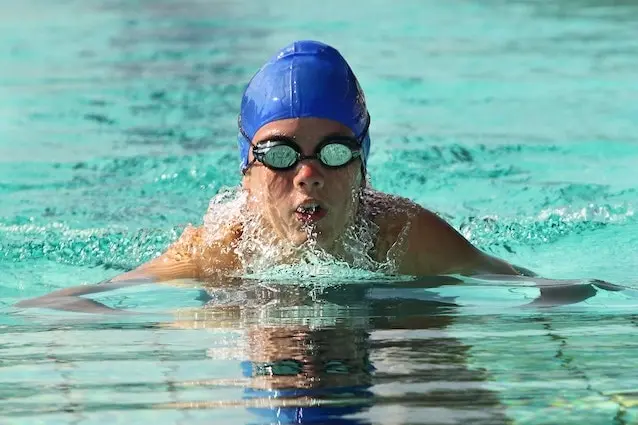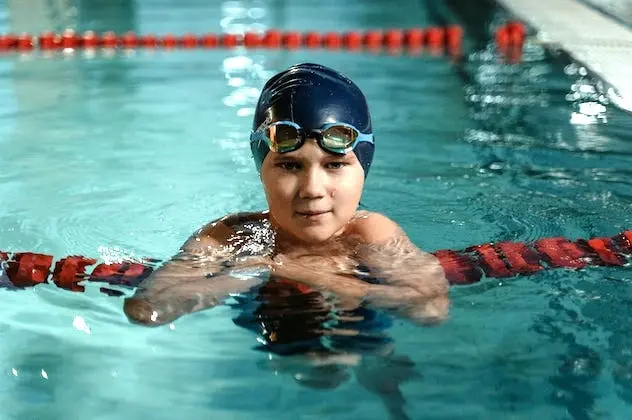8 Essential Tips for Choosing and Using Baby Swim Caps: Safety and Style in the Water
As a parent, you know how important it is to keep your baby safe and comfortable when they are in the water. You can do this by using a baby swim cap. In this article, we will show you the benefits of using a swim cap for babies. We will also provide you with some tips on how to choose the right one.
In this article
Should babies wear swim caps?
Babies do not have to wear swim caps in the water, but they can be beneficial for a few reasons.
To begin, swim caps can keep a baby’s hair out of their face and eyes while they swim. This is especially important for babies with long hair that may get in the way or tangle in the water.
Second, swim caps can help keep a baby’s head warm while they’re in the water by providing some insulation. This is especially beneficial for babies swimming in cooler water.
Finally, swim caps can protect a baby’s scalp from the harsh chemicals found in some pools. This is especially important for babies who have sensitive skin.
Are swim caps safe for babies?
Swim caps can be safe for babies if used properly, but certain precautions must be taken when using them.
To begin, select a swim cap that is appropriate for your baby’s age and size. Look for a cap that fits snugly but not too tightly, as too tight a cap can be uncomfortable and even pose a risk of choking or suffocation.
It’s also critical to keep an eye on your baby while he or she is wearing a swim cap. Never leave your baby unattended in or near water, and always keep a close eye on them to ensure their safety.
Finally, keep in mind that a swim cap is not a substitute for other water safety measures, such as proper swimming technique.
What type of swim cap is best for kids?

There are several types of swim caps suitable for children, and the best type will be determined by your child’s specific needs and preferences. Consider the following options.
- Silicone caps: The most common type of swim cap, made of a soft, stretchy silicone material. They are long-lasting and comfortable, and they are available in a variety of colours and designs.
- Latex caps are similar to silicone caps in appearance but are made of a thinner, less expensive latex material. They come in a variety of colours and designs, but they may not last as long as silicone caps.
- Lycra caps are made of a lightweight, stretchy material that some children find more comfortable than silicone or latex caps. They also come in a variety of fun prints and colours.
- Neoprene caps: Made of a thicker, insulating material, these caps are ideal for keeping children’s heads warm in cold water. They are frequently used in open-water swimming and triathlons.
Finally, the best type of swim cap for your child will be determined by factors such as hair type, water temperature, and personal preferences. You might want to experiment with a few different types to see which one your child prefers.
What are the best brands of swim caps?
Here are some top brands of swim caps for babies :
- Limmys Kids Swimming Cap: 100% Silicone Kids Swim Caps for Boys and Girls – Premium Quality, Stretchable and Comfortable Swimming Hats for Kids: Available in Different Attractive Colours
- Syhood 3 Pieces Kids Swim Caps Baby Waterproof Bathing Caps Children Cartoon Swimming Hat for Long and Short Hair Kids Boys Girls Toddler
- FUNOWN Kids Swim Caps for Kids, Children, Boys and Girls Aged 2–8, Baby Waterproof Bathing Caps for Long and Short Hair
- 2 pcs Kids Swim Cap Silicone Swimming Cap for Boys and Girls (Age 2-8) Cover Ears Waterproof Bathing Cap Keep Hair Dry Swimming Hat for Hair
- Happy Mane Silicone Swim Cap for Braids and Dreadlocks: Keeps Your Hair Dry While Swimming and Bathing Long Hair, Extensions, and Curly Hair Large Shower Cap for Women, Teenagers, and Kids
Why should babies wear swim caps?

There are several reasons why babies should wear swim caps when swimming. Here are a few examples:
- Swim caps can shield babies’ sensitive skin and hair from the damaging effects of chlorine and other chemicals found in pool water. They can also help prevent tangling and hair damage caused by pool toys and equipment.
2. Swim caps can keep babies’ hair out of their faces and mouths while swimming, lowering the risk of ingestion of pool water and potentially harmful bacteria.
3. Swim caps can keep babies’ heads and ears warm while swimming in cold water.
4. Swim caps may be more comfortable for some babies than traditional swimwear because they keep hair out of their faces and reduce drag in the water.
Overall, swim caps can be a useful tool for protecting babies’ skin and hair while also making swimming more comfortable and enjoyable for them. However, it is critical to select a swim cap appropriate for your baby’s age and size and to always closely supervise them when in or near water.
Is a silicon or lycra swim cap better?
It is up to you to decide whether a silicone or lycra swim cap is better for you. Consider the following factors when deciding between a silicone or lycra swim cap:
- Lycra swim caps are more comfortable than silicone swim caps because they are softer and stretchier. They are also less likely to yank hair or irritate sensitive skin.
- Silicone swim caps last longer than lycra swim caps because they are less likely to tear or wear out over time. They also have better shape retention and are less likely to stretch out of shape.
- Silicone swim caps are more water-resistant than lycra swim caps, which means they keep hair drier and better protect it from chlorine and other chemicals found in pool water.
- Lycra swim caps retain heat better than silicone caps, which is useful for swimming in colder water temperatures or for children who get cold easily.
Finally, both silicone and lycra swim caps are effective at protecting hair and improving swimming performance, so the choice is a matter of personal preference. A lycra cap may be a better option if you value comfort and flexibility. If you value durability and water resistance, a silicone cap might be a better option.
Will a swim cap damage hair?
Swim caps can cause hair damage if they are too tight or are not properly applied and removed. Swim caps can harm your hair in the following ways:
- Traction alopecia: Traction alopecia is a type of hair loss caused by constant pulling on the hair follicles. By pulling on the hairline and causing hair to break or fall out, a swim cap that is too tight can cause traction alopecia.
- Friction: If a swim cap is too loose, it can rub against the hair, causing friction, splitting ends, and breakage.
- Incorrect application: If a swim cap is applied or removed incorrectly, it can cause hair damage. Pulling a swim cap off from the front, for example, can cause hair to tangle or break.
To reduce the risk of hair damage while wearing a swim cap, choose one that fits properly and is not too tight or too loose. Without pulling or tugging on the hair, the cap should be put on and removed gently. Applying a leave-in conditioner or oil to the hair before putting on the cap can also help protect it from the chlorine and other chemicals found in pool water. Finally, it is critical to thoroughly wash the hair after swimming and avoid wearing the swim cap for extended periods, as this can trap moisture and bacteria against the scalp and hair, potentially causing irritation and infection.
What are the disadvantages of not wearing swimming caps?
There are several disadvantages to not wearing a swimming cap, including:

- Hair damage: Exposure to chlorine and other chemicals in pool water can cause hair to become dry, brittle, and discoloured. Chemicals can strip the natural oils from the hair, leaving it brittle and vulnerable to damage.
- Hygiene concerns: Swimming pools can harbour pathogenic bacteria and other microorganisms that can cause infections or illnesses. The risk of ingesting pool water or coming into contact with these pathogens is increased if you do not wear a swim cap.
- Increased drag: Long hair can cause drag in the water, slowing a swimmer’s speed and making it more difficult to move through the water efficiently.
- Distraction: Hair on the face can be a distraction while swimming, especially for children. This can make it difficult for them to concentrate on their technique and performance.
- Safety concerns: Hair can become entangled in pool drains or other equipment, endangering swimmers. Swim caps can help reduce the risk of entanglement and injury.
Overall, wearing a swim cap can help protect hair from damage, improve hygiene, reduce drag in the water, and improve swimming safety. While wearing a swim cap is not required, it can be a useful accessory for both recreational and competitive swimmers.
How do you put on a swim cap for kids?
Here’s how to put on a swim cap for kids:
- Ensure that the child’s hair is either dry or slightly damp. Wet hair can make putting on the cap difficult.
- Assist the child in putting their hair up in a ponytail or bun at the back of their head. The hair should be as flat against the head as possible.
- Place the swim cap on top of the child’s head, centring it and covering their hairline. If the cap has a front and back, place the front on the child’s brow.
- Smooth out any wrinkles or bumps in the cap with your fingers. This will help to ensure a secure fit and keep water out.
- Hold the cap in place with one hand while stretching the cap down over the child’s ears with the other. This will aid in creating a snug fit and prevent the cap from slipping off.
- Assist the child in securing the chin strap if the cap has one. This will aid in keeping the cap in place while swimming.
- Finally, ensure that the cap is secure and comfortable. Adjust the fit as needed if the child complains of discomfort or the cap slips off easily.
Always keep an eye on children when they are in or near water, even if they are wearing a swim cap.

Do swim caps prevent hair damage?
When swimming, swim caps can help prevent some types of hair damage. When swimming, hair is exposed to chlorine and other chemicals, which can cause dryness, breakage, and discolouration. Swim caps, which create a barrier between the hair and the water, can help protect the hair from these chemicals. Furthermore, swim caps can help reduce drag and friction on the hair, lowering the risk of split ends and breakage.
Do all swim caps keep hair dry?
No, not every swim cap is intended to keep hair completely dry. Swim caps are primarily intended to protect hair from pool water damage and reduce drag in the water, but they are not completely waterproof. Water can still seep into the cap through small gaps or openings around the edges, particularly if the cap does not fit tightly or is made of a thin or permeable material such as lycra.
Should swim caps cover ears?
Depending on the design and the swimmer’s preferences, swim caps can cover or leave the ears exposed. Caps that cover the ears can help reduce drag in the water and provide extra protection from pool water, whereas caps that leave the ears exposed may be more comfortable and easier to put on and take off.
Swim caps that cover the ears can be especially useful for competitive swimmers who want to reduce drag and increase their speed in the water. These caps are designed to fit snugly over the ears, resulting in a streamlined profile that can aid in water resistance.




